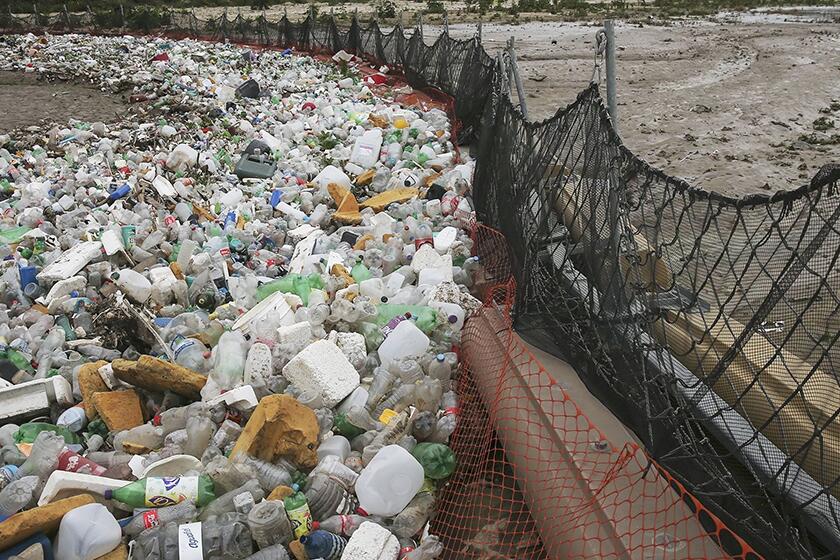The Tijuana River smells so bad, the CDC is coming to investigate

- Share via
San Diego County residents will have an opportunity to share their pollution concerns about the Tijuana River when officials from the Centers for Disease Control and Prevention arrive later this month to conduct a health survey.
This is the first time that a federal agency is investigating the potential harm caused by millions of gallons of raw sewage pouring through the Tijuana River that have caused beach closures of more than 1,000 days. Residents living near the river say they have been suffering unexplained illnesses, including gastrointestinal issues and chronic breathing problems, because of the stench of hydrogen sulfide.
“We’re continuing to lean in and listen in on what our community residents are feeling,” said Dr. Seema Shah, the interim deputy public health officer with San Diego County. Supervisor Nora Vargas first wrote to the CDC back in May, formally asking the U.S. Department of Health and Human Services to look into the health complaints.
This week, the county began reaching out to thousands of residents to inform them that the CDC is coming in the hope that they will be more receptive to answering questions. “This is our chance to be able to communicate [pollution concerns] on a national level,” Shah added.
As part of what the CDC calls a Community Assessment for Public Health Emergency Response, 210 households will be surveyed about their mental and physical health, as well as the pollution’s effects on property values. The families will be randomly selected from 30 clusters of neighborhoods where San Diego County has identified air pollution complaints in the Tijuana River Valley.
The Tijuana River has been polluted for decades, but in recent years, south San Diego residents say the smell — and their respiratory illnesses — has gotten worse.
Around 30 officials from the CDC and 50 graduate student volunteers from San Diego State University’s School of Public Health will be going door to door to conduct interviews with local residents over a three-day period. Here are the times when the survey will be conducted:
- Thursday, Oct. 17, 2024, from 2 p.m. to 7 p.m.
- Friday, Oct. 18, 2024, from 2 p.m. to 7 p.m.
- Saturday, Oct. 19, 2024, from 10 a.m. to 7 p.m.
The goal is to accommodate people’s schedules and, officials hope, catch them after work, Shah said. The volunteers are helping to bridge the language barriers with Spanish-speaking families.
“A lot of students, many of whom are bilingual, are from the community themselves,” said Paula Granados, an associate professor at San Diego State University’s School of Public Health, who’s been testing the Tijuana River for contaminants over the past month. “Our students are super excited. They want to help.”
The CDC could take weeks to months to release even the preliminary results from the survey, but for longtime residents like Bethany Case, this renewed attention already feels like a breath of hope.
“I just really want [this survey] to inform policy so that we don’t have to worry about our kids being sick,” said Case, the mother of two who’s lived in Imperial Beach for 16 years. For seven years she’s been an activist fighting to clean up the river as a volunteer with Surfrider, a nonprofit that works to preserve ocean access and cleanliness.
“I’m hoping that their survey shows that oftentimes it doesn’t just smell like sewage,” Case added. She doesn’t want the focus on the sewage to distract from the industrial waste that is dumped into the river that could be making people ill. “Oftentimes it smells like a chemical, it smells like a bite in the air, it burns your sinuses.”
Sewage carried into San Diego County by the Tijuana River last year broke all records since 2000.
Granados said the CDC’s survey is only a snapshot of what was going on when the data were collected, and conditions could worsen for residents when rainy seasons flood the river once more. Granados wants residents to know that even if they aren’t picked to respond to this survey, SDSU will be conducting its own yearlong survey that they can answer multiple times at tjriver.sdsu.edu.
“There’s research that’s still ongoing,” Granados said, and all that data will help policy decisions in the future. “We’re just committed to the long haul, whatever it takes to support the community.”
The county and other federal and state representatives have been working to raise awareness around the pollution to a national level.
Next week, the San Diego County Board of Supervisors will consider a proposal by Supervisor Terra Lawson-Remer to petition the Environmental Protection Agency to label the Tijuana River a Superfund site in need of remediation.









